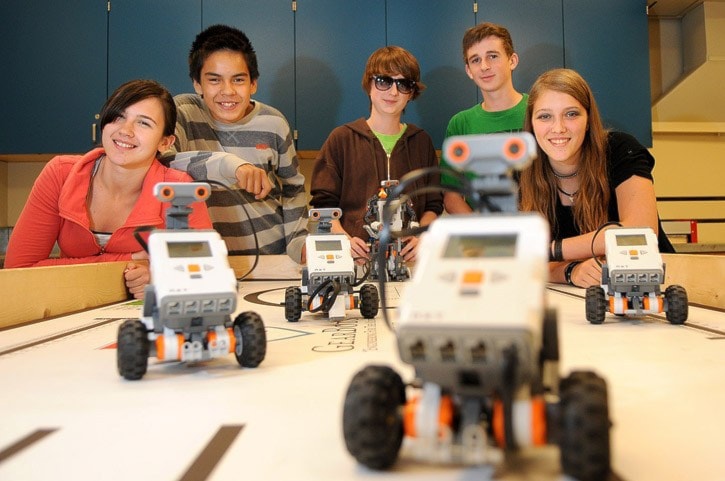If you had a chance to play with Lego in school, would you?
For a group of students at Chilliwack middle school this year, that was a no-brainer: Why wouldn't you, they asked.
This year CMS included a Lego robotics component into its Grade 8 science curriculum that has students building robots from scratch and programming them to complete a variety of different skills and tasks.
"When people ask me what I did at school today, I get to say I played with Lego," said student Sarah Wayenberg, a playful smile forming on her face.
But the thing is, while this course may look like mere child's play, it's actually heavily immersed in science and math concepts.
In building their grey and orange robots, which look to be a cross between Disney's Wally and Short Circuit's No. 5, students are investigating the transfer of energy, force, speed and the effects of friction. They're also measuring distance, circumference, and rotational speed using coordinate systems, and are regularly converting between decimals and fractions. They're programming and controlling input and output devises using wireless communication technology. And they're problem solving through building, testing and evaluating their robots.
All without opening a textbook.
"I see students who don't do well in academics come in here and excel," said teacher Ryan Gleeson. "They get As in this class, they lead the pack, they show other students how to do things."
Which is exactly what the Lego Group had in mind when it first developed the Mindstorms program. The company wanted to create a hands-on learning environment that would enable children, teens and adults to grasp science, technology, engineering and math concepts in a fun way.
With a kit that includes user-friendly programmable software, electric motors, sensors and Lego-technic bricks, students are building motorized robots and gaining skills that could be used in healthcare, engineering, computing, building and manufacturing industries.
CMS student Jonathan Bearshell, who excels in shop classes, but admittedly struggles in academics, loved the hands-on aspect of this course.
"It's not so much reading from a textbook and writing things out, you're actually using your hands and your mind to build something," Bearshell said.
And unlike other academic courses, mistakes are not penalized, but welcomed.
"Figuring out these challenges takes mistakes, and many times more than one mistake, but when you finally get it, it sticks," said student Natasha Farris.
The strong results in class was a good motivator for a group of students to start CMS's first robotics club.
On a cool afternoon, just minutes after the last school bell had rung, while most of their friends were already setting foot home, or planning their evening's activities, seven students in the robotics club were in a back room of the school's shop class working on three of the nine challenges they'd learned throughout the year.
The club had just come off a loss at the Skills Canada competition, but
these kids weren't wallowing, or even disappointed. Rather, they were learning, trying to fix their mistakes, better their outcome for next year.
"We were pretty much walking in [to the competition] blind," said student Randy McFarland.
"We knew there would be certain challenges, but we had no idea what was ahead of us," added Farris. "Now we know, and we're determined to do way better next year."
CMS plans to continue the robotics program for Grade 8 students in the 2012-13 school year, and hopes to have a Grade 9 curriculum developed for the 2013-14 school year.
